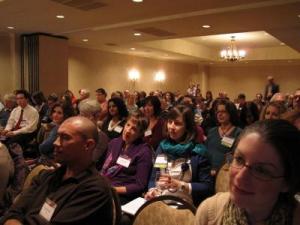The conflict between new media and old media or bloggers and journalists may seem like the hot topic these days, but at least one panelist this afternoon believes that such thinking is out of vogue. What is more important is talking about innovative ways to get science stories to people who don’t know it can be fun, even if that means mixing science in with news of Britney Spears, said panelist Bora Zivkovic at today’s session on “Rebooting science journalism: Adapting to the new media landscape.”
Bora, a newly minted blog editor at Scientific American, doesn’t see organizations such as his or Discover, Seed and Nature competing with each other in the new media landscape; rather he feels they are collaborators with a common mission. The real competitor, he says, is Britney Spears.
“We are all in this together now,” said Bora. “We are all in the same business of promoting science and pushing science literacy. I think if we figure out ways to collaborate, we can fight for our piece of the media pie and show people that science is fun, interesting and important.”
Fellow panelist Emily Bell left her post at The Guardian a few months ago to direct the Tow Center for Digital Journalism at the Columbia School of Journalism. She said her new role as a “hackademic” is giving her the time to think about how to crack very hard problems in journalism today. She admitted that she didn’t have the answer on how to keep our jobs – and not surprisingly none of the panelists could impart such wisdom – but she did convey one key mantra: nothing is ever going to stay the same.
And she happily gave a number of tips on how we as journalists could evolve to survive in the current climes. (1) Adapt your mindset to the fact that journalism is always going to be changing. (2) Realize that the content and the platform go hand in hand, and that you have to innovate both at the same time. (3) Differentiate yourself as a writer and a brand, developing a deep expertise or niche. (4) Understand the process, recognizing all the elements that go into a great story, whether it is the BP oil spill or the midterm elections.
Emily, who is creating a new program that combines computer science and journalism, emphasized that science journalists of the future are going to need a different skill set and a different way of thinking. She doesn’t see blogging and journalism as all that different, quoting that 35 percent of bloggers were or are currently employed as journalists.
“There is this snarky debate that the web creates bad journalism, and I just don’t agree with that,” explained Emily. “There is no dead air time on the internet, absolutely none. There is no set inventory to fill like in other venues – the stories are never finished, and they can continually be commented on.”
Blogging became a popular topic in the session – how to tell blog from a news article, how to tell a good blog from a bad blog, how to use blogging to get into writing. Bora, who was the first NASW member to be accepted on the basis of blog posts alone, recognized that blogging may be a new and frightening thing for a number of veteran writers. But he explained that for those who want to explore blogs, there are a number of science blogging networks that provide a stamp of approval on their content that is unparalleled in other subject matter such as politics or knitting. The moderator warned Bora not to antagonize knitting bloggers.
Bora’s reply: “I wouldn’t do that, they are powerful and they have needles.”




